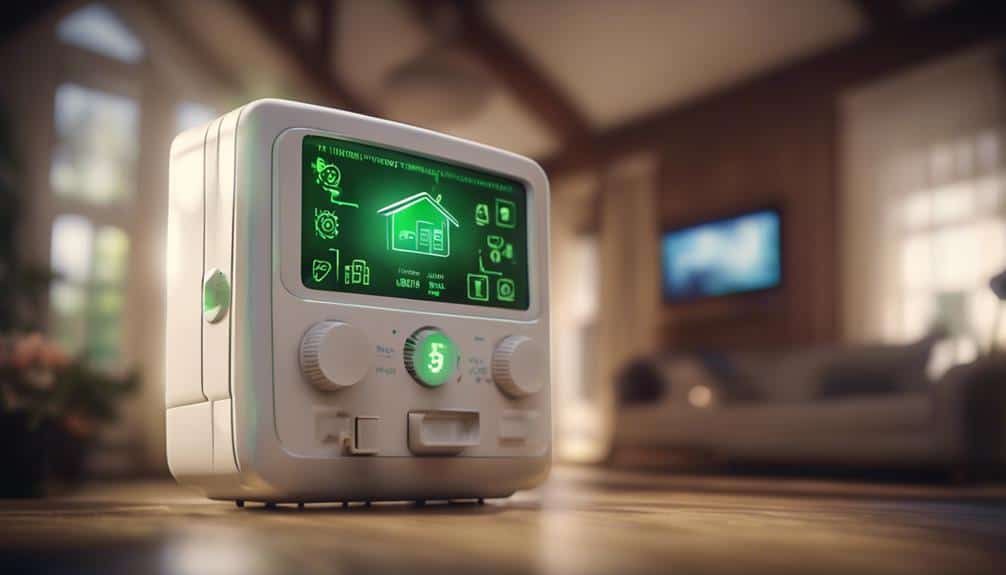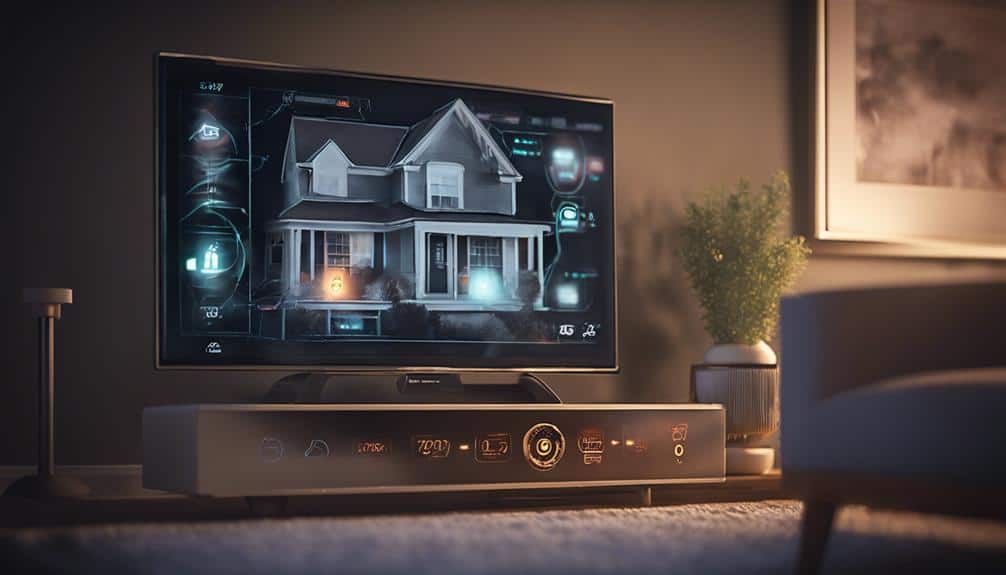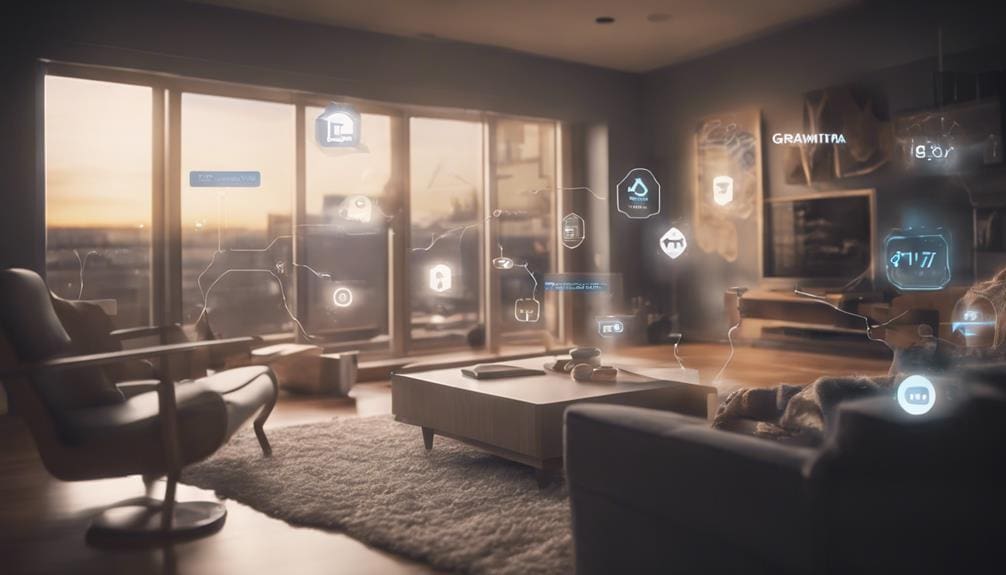Imagine you've just walked into a room that feels noticeably warmer than the rest of the house, despite the HVAC system running smoothly elsewhere. It's situations like this that underscore the critical importance of where you place your remote temperature sensors.
By positioning them away from direct sunlight, drafts, and other misleading influences, you're not just ensuring more accurate temperature readings; you're also enhancing your home's comfort and efficiency.
But there's more to it than just avoiding the obvious spots. Stick around, and you'll discover the subtleties of sensor placement that can make all the difference.
Key Takeaways
- Strategic sensor placement ensures accurate temperature readings, enhancing HVAC efficiency.
- Proper location of sensors can save up to 30% on energy bills by avoiding unnecessary heating or cooling.
- Placing sensors away from heat sources and direct sunlight prevents temperature fluctuations and maintains consistent comfort.
- Sensors in optimal locations help manage energy usage precisely, contributing to a sustainable environment and lower costs.
Optimal Sensor Locations
To guarantee your remote temperature sensors work effectively, it's crucial to position them in ideal locations, avoiding common pitfalls like dead air spots and direct sunlight.
By placing your remote temperature sensor below the 1st-floor central return, you'll achieve accurate indoor temperature and humidity readings. This spot avoids the inaccuracies caused by direct sunlight or proximity to supply vents and windows, which can mislead the sensor.
Central return vents are the sweet spot, providing stable temperature indications that enhance your HVAC's performance. This strategic placement ensures proper airflow, enhancing the reliability of the data collected. It reduces temperature fluctuations, enhancing your sensor's monitoring capabilities.
Enhancing Energy Efficiency

Understanding the best placement of remote temperature sensors not only guarantees accurate readings but also paves the way for a significant reduction in energy costs. By strategically positioning sensors, you're not just ensuring the comfort of your space but also championing energy efficiency.
Here's how you can make the most of it:
- Save up to 30% on energy bills by optimizing HVAC efficiency.
- Reduce energy waste through precise temperature control in needed areas.
- Prevent unnecessary heating or cooling, enhancing long-term savings.
- Enable targeted adjustments for maximum efficiency without sacrificing comfort.
Embracing these practices means you're not only cutting down on costs but also contributing to a more sustainable environment. Remember, it's the small changes that lead to big impacts.
Avoiding Temperature Fluctuations

To tackle temperature inconsistencies head-on, it's important you place your remote sensors wisely. By doing so, you're not just ensuring accuracy in readings; you're also setting the stage for reduced energy costs and a boost in system performance.
Let's explore how ideal sensor placement plays a key role in sidestepping temperature fluctuations.
Optimal Sensor Placement
When placing remote temperature sensors, it's vital to avoid dead air spots to make sure they provide accurate readings. To achieve this, let's focus on where exactly to position these sensors for peak performance, ensuring they reflect your home's true climate.
- *Place sensors below the 1st-floor central return* for reliable readings.
- *Guarantee proper airflow* around the sensor, avoiding dead air spots.
- *Select central return vent locations* as they accurately reflect indoor temperature and humidity.
- *Keep sensors away from high-traffic areas* to prevent damage and maintain sensor accuracy.
Reducing Energy Costs
Strategically placing your remote temperature sensors can greatly cut your energy bills by preventing unnecessary temperature fluctuations. By choosing ideal locations for these sensors, you're ensuring more accurate temperature monitoring. This accuracy is key to efficient HVAC system operation, which directly correlates to lower energy consumption.
You'll avoid the common pitfalls of overheating or overcooling your space, optimizing energy usage with precision. This approach to temperature monitoring means you're not just saving money; you're also maintaining consistent comfort levels without the energy waste.
Enhancing System Performance
Placing remote temperature sensors in just the right spots can greatly reduce rapid temperature fluctuations, boosting your HVAC system's efficiency. By avoiding these swings, you're not only saving on energy costs but also securing a more stable and comfortable indoor environment.
Here's how remote sensors can enhance system performance:
- Secure Temperature Fluctuations: Ideal placement stops rapid changes, keeping the space cozy.
- Maximize Efficiency: Less energy is wasted, thanks to steadier temperatures.
- Guarantee Accuracy: Get consistent readings throughout, avoiding hot or cold spots.
- Maintain Comfort: A stable environment means happier, more comfortable occupants.
With these steps, you'll see an improvement in both performance and satisfaction, proving that a little strategic placement goes a long way.
Critical Zones for Monitoring

You know the stakes are high when it comes to monitoring temperatures in places like server rooms and labs. By focusing on high-risk areas, you're not just protecting equipment; you're also ensuring everything runs efficiently and reducing environmental impact.
Let's explore how placing remote temperature sensors in these critical zones can make a big difference.
High-Risk Area Focus
In high-risk areas like server rooms and labs, ensuring precise temperature control is crucial for safeguarding sensitive equipment. Deploying a remote sensor in these critical zones not only protects your investment but also maintains the integrity of your operations. Here's why focusing on these areas is non-negotiable:
- Real-time monitoring: Instant alerts to temperature spikes or drops.
- Prevention of thermal shutdowns: Keeping equipment within safe operating temperatures.
- Protection against data loss: Ensuring data integrity by avoiding equipment malfunctions.
- Best conditions: Maintaining environments where sensitive equipment can operate efficiently.
With these strategies, you're not just protecting your assets; you're ensuring they perform at their best, day in and day out.
Equipment Efficiency Monitoring
Monitoring your equipment's efficiency in critical zones like server rooms and data centers is key to preventing costly downtime and ensuring peak performance.
Remote temperature sensors play an essential role here. By placing these sensors in critical zones, you're not just guessing the conditions; you're actively monitoring and responding to real-time data. This vigilance helps prevent equipment overheating, data loss, and expensive repairs. It's all about keeping your operation humming smoothly.
With the right placement, these sensors provide accurate readings, ensuring your equipment operates efficiently. This not only enhances system reliability and performance but also extends the longevity of your valuable assets.
Environmental Impact Control
Understanding the environmental impact within critical zones like server rooms requires vigilant control and monitoring of temperature variances. By placing remote temperature sensors in these areas, you're not just ensuring the smooth operation of your equipment; you're also taking a significant step towards environmental impact control.
Here's why it matters:
- Prime performance: Keeping equipment at the right temperature prevents overheating, ensuring everything runs as it should.
- Equipment longevity: Proper temperature control prolongs the life of your equipment, saving resources.
- Energy efficiency: Monitoring helps maintain energy efficiency, reducing your carbon footprint.
- Prevents downtime: Real-time alerts help you address issues before they lead to costly failures.
Maximizing Comfort and Safety

To maximize your comfort and safety, it's important to place remote temperature sensors in ideal locations. By doing so, you guarantee accurate readings that prevent temperature swings, keeping indoor conditions consistent and comfortable.
Strategically placed sensors not only enhance the efficiency of your HVAC system, leading to energy savings and lower utility costs but also improve well-being, productivity, and satisfaction by maintaining perfect temperatures. Remember, accurate temperature monitoring in key areas is critical.
It's these remote sensors that play an important role in providing the real-time data needed for effective climate control, ensuring a safe and comfortable environment. So, consider the significant benefits of perfect sensor placement for your comfort and safety.
Key Considerations for Placement

Consider several key factors when deciding where to place your remote temperature sensors for best performance. Proper placement isn't just about putting it anywhere; it's about understanding your environment and how it interacts with temperature. Here's what you need to keep in mind:
- Stay away from heat sources like ovens and windows with direct sunlight to avoid skewed readings.
- Avoid airflow disruptions such as drafts or vents that could affect sensor accuracy.
- Choose central return vent locations for a reliable temperature indication of your entire space.
- Guarantee proper airflow around the sensor by steering clear of dead air spots for the most accurate temperature readings.
Enhancing Device Longevity

Maintaining ideal temperatures through remote sensing can greatly enhance your devices' longevity and reliability. Proper temperature monitoring prevents overheating, a common culprit behind shortened electronic lifespans.
By using remote temperature sensors, you're not just guessing; you're actively ensuring your devices operate within their best conditions. This vigilance reduces the risk of premature failure, saving you from unexpected breakdowns. Monitoring temperature variations shields sensitive components from damage, securing reliable performance.
It's like giving your devices a protective layer against thermal stress, preserving their functionality and extending their lifespan. Plus, with real-time data at your fingertips, you can proactively tackle temperature issues, bolstering the durability of your electronic equipment.
It's a smart move for anyone looking to safeguard their investments.
Balancing Temperature Across Zones

Strategically placed remote temperature sensors help you balance heat distribution across different zones, optimizing comfort and energy efficiency. By keeping an eye on various areas, you'll guarantee everyone stays cozy without wasting energy.
Here's how sensors make a difference:
- Monitor temperature variations: Sensors identify spots that are too hot or cold, allowing for quick adjustments.
- Optimize HVAC performance: Fine-tune your system to deliver just the right amount of heating or cooling.
- Prevent overcompensation: Avoid cranking up the heat or AC in one area, saving on bills.
- Ensure uniform comfort: With sensors, every corner of your space feels just right.
Preventing Heat Loss and Gain

After exploring how sensors can balance temperatures, let's focus on how they also prevent unwanted heat loss and gain, keeping your energy bills low and comfort high. Placing remote temperature sensors in just the right spots is vital.
It's not just about getting a read on the air around you; it's about smartly managing your home's climate. By avoiding areas near heat sources or drafts, sensors guarantee your HVAC system operates efficiently. This strategic placement means you're not overworking your system to compensate for skewed temperatures. The result? Consistent indoor comfort without the energy drain.
Basically, these sensors are your frontline defense in maintaining an ideal temperature, making sure you're not paying to heat or cool the great outdoors. With sensors properly placed, you're set to enjoy a comfortable home and a lighter energy bill.
Strategic Placement for Accuracy

To make sure your home's climate control is both efficient and accurate, it's crucial to place remote temperature sensors correctly. Strategic sensor placement isn't just about picking a spot; it's about understanding how your home breathes and reacts to different conditions.
Here are some tips to help you get it right:
- Place sensors below the 1st floor central return for an accurate reflection of indoor temperature and humidity.
- Avoid dead air spots and guarantee proper airflow for sensor reliability.
- Keep sensors away from supply vents, windows, and direct sunlight to avoid skewed readings.
- Consider relocating the entire thermostat based on HVAC contractor recommendations for the best performance.
Frequently Asked Questions
Where Should Temperature Sensors Be Placed?
You should place temperature sensors about 5 feet high on an interior wall, ensuring good air circulation for accurate readings, especially in industrial applications. Avoid hot/cold equipment and direct sunlight for the best results.
What Does a Remote Temperature Sensor Do?
A remote temperature sensor measures temperatures from afar, ensuring you're always informed about any changes. It's vital for sensor calibration, keeping your spaces at best conditions without needing to be there physically.
Where Should I Put My Temperature Sensor in My House?
You should place your temperature sensor about 5 feet high on an interior wall. Avoid hot/cold sources and direct sunlight for accurate sensor calibration. Choose a central location with good airflow and away from doors.
What Is the Difference Between Remote and Local Temperature Sensors?
Remote temperature sensors are placed away from the main thermostat, capturing specific area temps, while local sensors are built into it, often missing variations. This difference in sensor technology guarantees more precise temperature control for you.
Conclusion
So, you've got the lowdown on where to place your remote temperature sensors. By sticking to the sweet spots away from direct heat, sunlight, and drafts, you're not just boosting your energy savings but also dialing up comfort and protecting your HVAC investment.
Remember, it's all about keeping those temps steady, ensuring every room feels just right. Regular checks? Absolutely. They keep everything running smoothly.
Here's to a perfectly balanced, cozy, and efficient home. Cheers to smart sensor placement!

